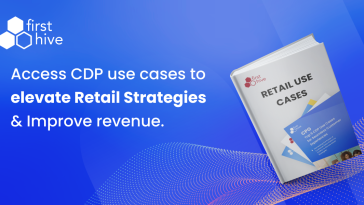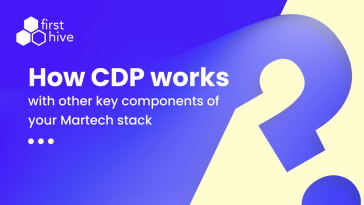That quarter in your calendar year when you evaluate tech solutions and implement them into your organization is the most heated one. As a marketing chief, you may continue to add tools and technologies that would help marketing operations. You may use it to build better customer relationships or optimize your ROI. But, soon you would realize that no single tool would solve the problem for them.
These tools need to be brought onto a single platform in a cohesive manner. The platform needs to enable the tools within your marketing systems to talk to each other.
The platform needs to identify customers, define customized paths and channels for interaction, create consistent communication, and achieve a recurring purchase cycle driven by loyalty building. Though in the digital age, CDPs like FirstHive not only consolidate online channels but also include data coming from offline sources.
CMOs and CDPs – Finding Answers To A CMO’s Strategy
A CMO’s strategy begins with questions that evaluate problems and find solutions. Take a look at the marketing canvas, here below, that you have to fix. Adding a Customer Data Platform (CDP) to this flow and sequence of marketing activities may be a matter of question. , where exactly would you place it?

It may get as confusing as it seems.
A CDP is a central engine that drives the marketing systems in the desired direction. Take a look at the image below.

This explains why a Customer Data Platform becomes your strategic priority.
Here are sets of questions that other CMOs encounter in the absence of a Customer Data Platform (CDP). A CDP is designed to answer and provide solutions to these questions.
This checklist would be a primer that would help you understand the strategic value of a CDP. It helps you establish how a CDP helps in enhancing customer experiences and also in selling your point across to the board and management about the need for a CDP within your organization.
A CMO’s Customer-related Questions
- Who is your real customer?
- What channels are being used by each customer?
- Which is the most effective channel to communicate with your customer?
- How much does each customer like or not like your product or brand?
- What problem is your product or service solving for each customer?
- After the customer has already bought your product how likely is it that the customer will buy the product once again?
- Do advertising and promotions have a direct impact on the customer’s willingness to buy?
- How far or close is your potential customer on the buying process?
- How to identify customers across different channels?
While these questions are directed to customers, CDPs can also be used to define an audience other than customers and build a campaign around them. Example of this audience is influencers, partners, potential employees, and key stakeholders.
A CMO’s Technology Questions
- Are you able to integrate all your digital marketing tools to create a unified customer experience?
- How do you bring customer data from across all tools used within the organization and place them together?
- How to achieve quick tool configuration for marketing purposes and minimize dependencies on the tech team?
Customer Behavioral Questions
- What products are purchased on a recurring basis?
- Are there certain products preferred during a certain season?
- Do they respond only to specific offers?
- Does the customer associate certain communication with certain offers?
- What is the purchase history?
- Which channel works for each customer for different stages of the buyer’s journey?
- Who are the influencers of a purchase decision?
- How to minimize customer brand fatigue as a part of the user experience? How make them more loyal?
These questions can only help you derive the initial strategic value in adding a CDP for your organization. But, here is the real reason why a CDP is of Strategic value to your larger marketing plan.
Adding Intelligence To Your Marketing Systems
A combined nature of deterministic and probabilistic mapping techniques bring an element of intelligence while identifying a customer across the marketing universe of channels. Imagine if some customer data already exists in one of the tools that is being used in-house but while designing a campaign the lack of knowledge of such information leads you to create inconsistent communication. With large data sets, it is impossible for marketers to rely on a limited set of tools and yet achieve a single view.
A single view of the customer can be created by a single platform. A CDP allows data to be ingested into the platform from both internal and external sources. This relieves you from juggling with multiple platforms and tools.
Addition of Artificial Intelligence helps in predicting customer behavior and responses to the campaigns that are being designed in the pipeline. With machine learning ingrained into it, learning about the customer remains in the continuum. It relieves the marketer from segmenting manually. Auto-segmentation becomes the new way of cohort management with a CDP.
Technically, a CDP becomes the central brain of intelligent systems of marketing. Often the need to use a customer data platform arises with the need to identify your customers, decipher third-party anonymous data, run automated campaigns or derive recommendations. There is more than one use case a CDP can solve for you.
Share with us how you are solving the most challenging marketing problems that come in the way of your strategic goals.
Talk to an expert 1:1. Schedule a call with us. Sign up here








